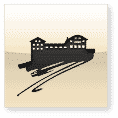From carnotzet to barrique cellar
The old Carnotzet is history. The memories are stored. Space for new things has been created. A bit of melancholy resonates. But we are sure that the barriques in the same place will give us many beautiful events and wine experiences. Surrounded by tufa walls, our Vinum Lignum products mature.
What remains are two letters, an A and an M. The two letters have always been present with us, as you can see on our old logo from the 1950s. Now we are looking for a nice place for our company initials.
But there are also other things happening in our buildings. Our bottling line is getting old and needs to be replaced. Third-party bottling has been an issue, meaning we take our wines and bottle them in another cellar and take the bottles back. Or that a mobile bottler will join us in the cellar and bottle for us as needed. However, it quickly became apparent that these variants were not only more expensive, but that they also did not meet our needs.
Constant pumping and transportation are not optimal for the wine. The amount of bottles we fill is too high and yet too small: in the total amount of bottles we bring it to a handsome figure, but if you break it down, it looks different again. Our specialties such as Amphora®, Forestier® or Domaine de Ravoire® are too sensitive wines to be transported back and forth.
We work with nature, accompany our wines in a natural way and are not satisfied until these wines are safe and sound with you. The whole process is becoming more and more complex. Vineyards and vinification require a lot of intuition and cannot always be treated analytically and scientifically. It takes a healthy gut feeling, knowledge and experience. What am I getting at? We work on a wine for about 1½ to 3 years, with all our emotions, knowledge and experience. No step is self-contained; each one affects the next.
We experience many joyful moments, but also sleepless nights until the wine is “bottle-ready”. Actually, you might think, bottling is not an art. It just is! We work on a wine for up to 3 years and then we bottle it through a machine. The things that can happen: Air infiltration, dirty pipes, hygiene problems – in short, bottling can undo the previous work in the vineyard and during vinification.
It pays to have a handle on these 90 seconds or so in which the wine goes into the bottle. It’s a little reminiscent of working in an operating room.
We have determined the new machine, are in the preparatory planning for the removal of old
machine, the adaptation of the building infrastructure and the installation of the new machine. Ideally, we will be able to tell you about it in the next Rhoneblut newspaper and provide pictures of the new bottling
show And it goes on: We could find an agreement with the parish, respectively the diocese of Sion, and take over the adjoining ground of the winery. More on this, too, in the next Rhoneblut.



